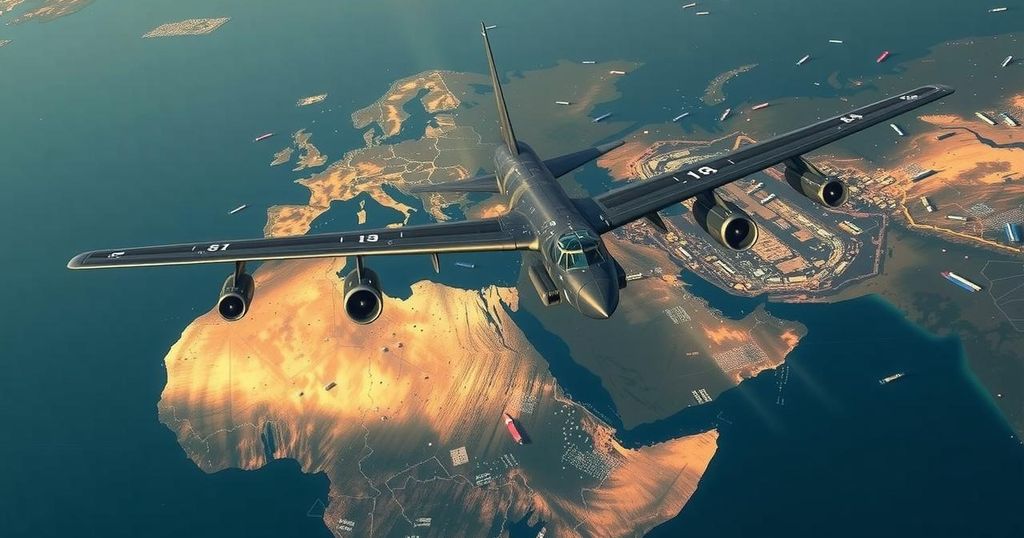The U.S. deployed B-52 bombers to the Middle East to deter Iran, while Israel issued evacuation orders for parts of Lebanon, warning of imminent strikes on Hezbollah. Meanwhile, Iran marked the anniversary of the 1979 hostage crisis with protests, and tensions rose with reports of an Iranian-American journalist detained in Iran. Protests in Israel highlighted dissatisfaction with the government’s handling of hostages in Gaza.
On Saturday, American B-52 bombers were deployed to the Middle East, following an announcement by Washington aimed at sending a stern warning to Iran. The Pentagon confirmed that this military maneuver is intended to safeguard American personnel and interests within the region. The situation continues to evolve, and updates will be provided through our liveblog. In related developments, the Israeli Defense Forces (IDF) issued an evacuation order for residents in the Baalbek area of eastern Lebanon, citing imminent strikes on Hezbollah installations in both Baalbek and nearby Douris. Avichay Adraee, the Arabic spokesperson for the IDF, emphasized the urgency of this evacuation due to the threat posed by Hezbollah’s facilities in the area. Iran marked the anniversary of the 1979 hostage crisis with demonstrations outside the former US embassy in Tehran. Activists expressed their anti-American sentiments, chanting anti-U.S. and anti-Israel slogans, demonstrating the long-standing tensions between Iran and the U.S. that originated from the crisis. During the occupation, 52 hostages were held for 444 days, a pivotal moment that derailed diplomatic relations between the two nations. Moreover, protests erupted in Tel Aviv, where hundreds of citizens expressed discontent with the Israeli government’s inadequacy in securing a truce for the remaining hostages in Gaza. Protesters displayed placards calling for immediate action and peace. The tensions escalated as officials revealed that an Iranian-American journalist, Reza Valizadeh, has been imprisoned in Iran for several months. His detainment has emerged amid heightened threats from Iran’s Supreme Leader, Ayatollah Ali Khamenei, who promised a strong response towards Israel and the United States as B-52 bombers arrive in the region. The U.S. State Department acknowledged awareness of Valizadeh’s arrest and stated that it is collaborating with Swiss officials, who represent U.S. interests in Iran, to gather more information on his case. In conclusion, America has positioned B-52 bombers in the Middle East to deter potential Iranian aggression, amidst escalating tensions marked by military threats, protests, and the ongoing hostage situation in Gaza. The developments highlight the complex and fragile state of affairs in the region, necessitating continuous monitoring and diplomatic efforts to prevent further escalation.
The article discusses the recent deployment of U.S. B-52 bombers to the Middle East, highlighting their intended purpose as a deterrent against Iran amid growing regional tensions. It touches upon simultaneous developments, such as Israel’s military actions against Hezbollah, Iranian commemorations of the 1979 hostage crisis, and ongoing protests in Israel related to the hostage situation in Gaza. The situation is compounded by the arrest of an Iranian-American journalist in Iran, further straining relations between Tehran and Washington, against the backdrop of aggravated military threats.
In summation, the deployment of American B-52 bombers serves as a strategic warning to Iran, coinciding with military operations by Israel against Hezbollah. The continued commemoration of historical hostilities affects public sentiment in Iran, while protests in Israel reflect domestic uncertainties regarding hostages in Gaza. These events collectively underscore the volatile nature of international relations in this tumultuous region, necessitating careful diplomatic navigation.
Original Source: www.france24.com






